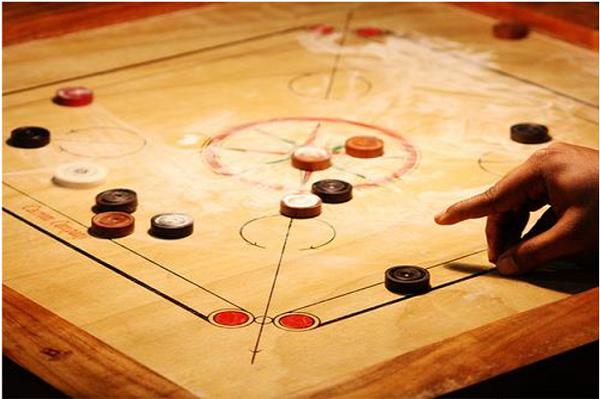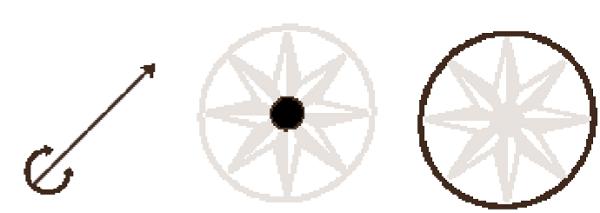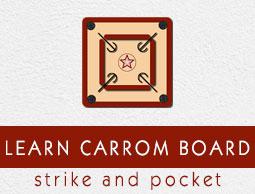Carrom - Quick Guide
Carrom – A Board Game
Overview
Carrom is a popular indoor game, believed to have originated in India in the 18th century. Widely played across the Indian subcontinent, Carrom requires a good sense of angles and superlative precision and concentration. It was once played − mostly by children and ladies − for amusement, but now it is being played at competitive level in an organized manner.
Objective
Carrom is played on a square polished plywood board with a striker made of hard plastic and small circular wooden pieces called carrommen.

The basic objective of carrom is to use the striker with a flick of the finger to drive the carrommen into any of the four corner pockets. The game is about pocketing the carrommen and the queen before the opponent, and scoring maximum points to win. Know more about this game and its laws by reading further.
Team Size
Carrom is either played singles or doubles in men’s and women’s category. In fact, this is one of those few board games where doubles is allowed. Unlike other indoor games, there are no mixed doubles team. As obvious, the maximum team size is two when playing a game.

Participants from various countries form teams for major tournaments or championships conducted across the globe.
Carrom – Participating Countries
Carrom originated in India, and the neighboring countries easily accessed and learned the game. Over the years, Asian countries have dominated this game and they are considered to produce world’s best players in Carrom.
Asian Countries Participating in Carrom
Apart from India, millions of people from countries like Sri Lanka, Japan, Korea, Singapore, Bangladesh, Maldives, Nepal, Malaysia, and Pakistan participate in carrom game. Most of these Asian countries also have their own Carrom Confederation bodies.
The Asian Carrom Federation is the governing body of all these individual confederations. It plays the lead role in conducting carrom championship for SAARC countries every year.
Japan was introduced to carrom in early 20th century where it is fondly called as tokyu-ban, which means ‘fight ball board’ in English. It lost steam mid-way but many still play tokyu-ban in Hikone city.
Non-Asian Countries Participating in Carrom
Carrom is gaining popularity in Europe and North America. Countries like France, Germany, UK, Greece, Italy, Spain, Switzerland, etc. have also formed their carrom federations.
The European Carrom Confederation coordinates all the activities related to carrom with these countries. They also have rolling Euro Cup championship every year.
Countries like Australia and United States have also picked up the game and it is rapidly gaining popularity amongst the citizens. The United States Carrom Association coordinates with individual state bodies to conduct tournaments locally and extract best talent.
Carrom – Playing Environment
First of all, the necessary arrangements are to be made and a proper playing environment has to be set up before sitting down to play carrom. The carrom board is placed on a stand and players occupy the chairs on its four sides.
Carrom Board Design
The board has a design on it with a decorated circle at its center, base lines on four sides, and arrows pointing towards the net holes located at the four corners. There are circles at the end of every base line called base circle. The carrommen are arranged inside the circle at the center and struck with the striker.

The playing surface of a carrom board is normally made of plywood and it is at least 8 mm thick with a completely smooth surface. The frames around the playing surface are made of wood which rise above the playing surface to a height of 1.90 cm to 2.54 cm. The width of the frames can be anywhere in between 6.35 cm to 7.60 cm.

Any carrom board has four arrows drawn on it at each corner, as shown in the above picture. Exactly at the center of the board is the Center Circle colored red. Around the center circle is the Outer Circle inside which the carrommen are arranged.
Dimensions of a Carrom Board
Carrom boards come in different sizes, depending on who is going to use it. Sometimes, they are made of plastic as well. However, the boards that are used in professional gaming events have a standard dimension. Take a look at the following image. It shows the exact dimensions of a standard carrom board.

Carrom – Equipment
Apart from the carrom board itself, one would normally get to see the following equipment when a game is on.
Carrommen − The Carrommen are circular pieces of wood colored black, white, and red. There are nine black, nine white, and one red (queen) carrommen on a board. |
 |
Striker − This is also a circular piece, normally made of plastic that is used to strike the carrommen. A striker is bigger in dimension than a carrommen. |
 |
Net − Each corner hole is covered from beneath by nets fixed at the bottom of the Carrom board. |
 |
Powder − A unique powder made of boric acid is sprayed on the board for players to flick and pocket the carrommen smoothly with the striker. |
 |
Stand − The carrom board is placed on a stand so that the game can be played at a comfortable height without the players having to bend their back too much. |
 |
Light − A light is hung over the board for better visibility and it produces heat that ensures the powder doesn’t stick to the board. |
 |
Popular Terms In Carrom
You must familiarize yourself with the following terms before playing carrom −
Queen − It is a red colored carrommen placed at the center of the board at the beginning of the game.
Foul − Any wrong strike by the player is considered a foul. She/he has to miss their turn and stand a penalty of one carromman.
Break − The first strike on the board is called a break.
Push − A sudden jerk of the board while playing is called push. It is a kind of foul.
Strike − Player hitting the carrommen with a striker directly or indirectly.
Due − A penalty term, when the player commits a foul and places his carromman in the center.
Penalty − A penalty is different from foul and this is applicable when player violates the laws of carrom.
Covering − It means pocketing a carromman as cover for the queen.
Thumbing − Any proper strike played with thumb is called thumbing.
White slam − It means pocketing all white carrommen with or without queen in first strike or turn.
Black slam − It means pocketing all black carrommen with or without queen in first turn.
How To Play Carrom?
The broad objective of carrom is to use the striker with a flick of the finger to drive the carrommen into any of the four corner pockets. The aim of the game is to pocket one's nine carrommen along with the queen before your opponent.
As mentioned earlier, carrom requires a lot of concentration, practice, precision, and a good sense of angles. Above all, it is important to know the laws of carrom and how to play the game.
Getting Ready
In singles, the players sit opposite to each other. In doubles, partners sit opposite to each other and opponents sit on either side.
The players are not allowed to lift and move the chair or table to reposition themselves for strike. However, players can change their positions without moving the seat.
A player is not allowed to take support of objects around and play the game.
The game begins with a toss where a referee hides either a white or a black carrommen in his hands. The player who calls it correctly wins.
The player who wins the toss gets the choice to either strike or change sides. If she/he chooses to change sides, then the strike automatically goes to the opponent.
The referee then arranges the carrommen at the center of the board with the queen in middle of the arrangement. Nine black and nine white carrommen are used for this arrangement.
The black and white carrommen are placed alternately in circular formation around the queen. The arrangement should not cross the outer circle.
Quick Glimpse of the Game
Before we get into the rules of the game, here is a quick glimpse of the first round that demonstrates how the strike moves among the four players.
Let’s assume, there are two teams of two players each. The team that wins the toss gets the opening strike and the two players can decide between them who wants to take the first strike.
The player who strikes first plays with white carrommen and attempts to pocket them.
If he pockets a carrommen, he gets another hand to strike.
If he misses to pocket, then the strike passes to the opponent player sitting right next to him in anti-clockwise direction.
The opponent player in his turn attempts to pocket the black carrommen and the game continues as the players take turns to strike alternate white and black carrommen.
Striking
While striking, players should ensure that only their playing arm rests on the board and no other part of the body is touching the board.
The player striking first should position the striker on the base line and strike in one go. The player is not allowed to jerk the striker or the board when striking, as it will be considered a foul.
The opportunity to break shifts alternately in singles game. In doubles, the break moves in anti-clockwise direction.

The opponent does not get a strike until the player who breaks or strikes doesn’t pocket a carromman.
While positioning the striker on the base circle, it should not touch the imaginary line at any moment of play.
When a player’s strike or turn is over, the referee is responsible to pass the striker to the opponent if needed. Players are allowed to play with personal strikers provided they abide by the laws of carrom.
Covering the Queen
Queen can be pocketed after the player nets at least one of his carromman.
The player has to cover the queen by pocketing his carromman, in which case, the points of queen will be awarded the player goes on to win the board.
Each black and white carromman carries one point and the queen carries three points.
A player gets the points of queen if it is covered and the player wins the board.
A board comes to an end when the opponent’s carrommen are left and rest all are pocketed. The winner gets points equal to the number of opponent’s carrommen left on the board plus the points of queen if the winner of board has pocketed it. Else, the winner gets points equal to number of carrommen left on the board. In such case, the opponent doesn’t get queen’s points since the player has pocketed it.
If a player pockets queen and the striker in one proper strike, then the queen and additional two carrommen are placed in the circle for the player to continue with his turn.
If the player pockets a cover with the striker, then the queen plus two carrommen come back into the circle. The player then continues to play. It is same even when the queen and opponent’s carromman are pocketed by mistake. Just that the opponent’s carromman is not placed in the center.
Suppose, a player has due without pocketing any of his carrommen, then the first carromman pocketed will return to the board and player continues with strike. In such case, the player can now pocket the queen first and cover it.
If only one carromman of each player is left on the board with queen and the player to strike pockets queen and opponent’s carromman then, opponent wins the board and gets points equal to number of carromman left on board.
If a player pockets queen and the carromman in a single strike, then queen is considered to be covered.
Scoring
The total points of a board game are 25. The players cannot count on queen for 21 and above points. The player who gets to 25 first is declared winner of a game.
A player is given 10 seconds to strike or break. Post that, the opponent gets the opportunity.
There are a maximum of eight boards played. A player who gets to score 25 points first within this number of boards will be the winner or a player with maximum points by end of eight boards will be the winner.
All the eight boards must be finished within 25 minutes from the start of play. If unfinished, then the player with maximum points by the end of the last board will be declared as the winner.
Fouls
A foul committed by a player results in a due or penalty. Following are few common instances of foul −
A player disturbs or touches the board or carrommen while idle or playing. It is considered as a foul and the player has to pay a due of one carromman.
If a carromman bumps out of the board in a strike or play, the striking player loses the turn.
A striker if pushed to hit the carrommen is considered a foul and a penalty of one carromman is given or the player loses his turn.
If a player pockets the striker alone or the striker with a carrommen, then it is a foul. As a penalty, the carromman is returned back on to the board and the player loses his turn. In such a case, the opponent gets chance to place the carromman anywhere inside the circle. Further, the striking player loses his turn.
If a player pockets the queen first in strike or turn, then it is a foul.
Carrom - Variants
When carrom is played at a professional level in tournaments, there is only one fixed format, i.e., Board. However, carrom can be played in other ways too, but they are predominantly meant for amusement.
Board
Board is a format that is played at professional level. In this format, each carromman is accorded one point and the queen carries three points. There are only eight boards played at the professional level to decide the winner based on points. The limit is 25 points and this level has many laws to follow to play the game.
Total point
Total point is a funnier side of the game where a player is free to pocket any carromman. Black carries five points, white carries 10 points, and queen 25 or 50 points depending on the group. This is either played as individuals or groups at home. The individual or group left with the maximum point is declared the winner after numerous rounds. In general, all nine white and black carrommen with queen on top are piled at the center. Randomly, one player strikes first and keeps the strike as long as he is able to pocket a carrommen in every strike, else the strike is passed to another player when a carromman is not pocketed.
Duboo
Duboo is a form of carrom, played mostly in Karachi, Pakistan. It is played on a board that is larger than a usual carrom board. In this format, the striker is slid across the board and not flicked as done in professional carrom.
Tokyu-ban
Tokyu-ban which means 'fight ball board’ in English is a type of carrom that is played in some part of Japan.
Carrom - Tournaments
Carrom has become quite popular over the years and many countries are coming forward to learn and organize professional tournaments. Following is a list of various international tournaments organized in 2013–14 −
| Tournament Name |
Venue |
| 17th SAARC Countries Carrom Championship |
Kolkata, West Bengal |
| 5th Asian Carrom Championship |
Kolkata, West Bengal |
| 1st World Junior Carrom Championship (under 19) |
Gurgaon, Haryana |
| International Champion of Champions Tournament |
Gurgaon, Haryana |
Many countries have their own organizing bodies and they conduct championships at national level to pick the best players who can represent their nation at the international level. Most of these international tournaments are conducted in Asian countries.
Carrom - Champion of Champions
The International Carrom Federation is the global governing body of the game. International Olympic Committee has also recognized the sport in 1990s. India and Sri Lanka have produced world champions over the years in carrom. Following are some of the current champions in men’s and women’s category.


| Player Name (Women) |
Country |
| Rashmi Kumari |
India |
| S. Ilavazhaki |
India |
| Kavita Somanchi |
India |
| M. Parimala Devi |
India |
| Roshita Joseph |
Sri Lanka |
| Yashika Rahubaddah |
Sri Lanka |
| Madushika |
Sri Lanka |
| Chalani Lakmali |
Sri Lanka |
Note − A. Maria Irudayam from men’s category and N. Nirmala from women’s category have been equally popular internationally. Both of them were national champs of India and lifted the trophy nine and six times respectively.
















